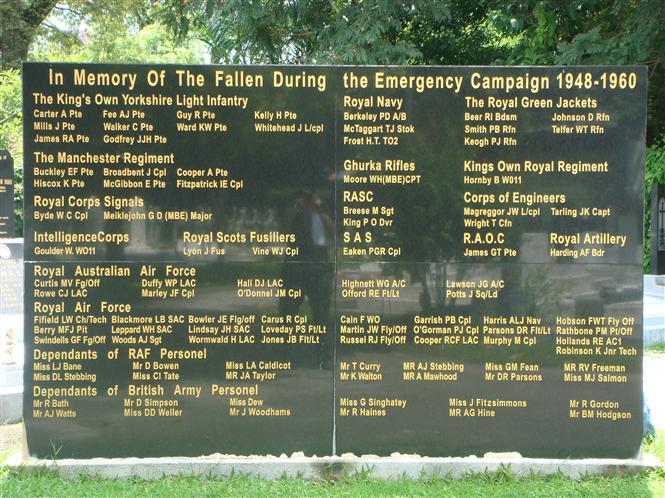Malayan Emergency Memorial, Penang
Description
Also known as Western Road Cemetery Memorial or the Emergency Campaign Memorial: a large polished black granite memorial inscribed in gold 'In memory of the fallen during the Emergency Campaign 1948-1960'.
History
The Malayan Emergency was declared on 18 June 1948, after three estate managers were murdered in Perak, northern Malaya. Australia's involvement in the Emergency began in 1950 with the arrival of RAAF aircraft and personnel in Singapore.
One of the major military successes of the conflict was a coordinated operation in July 1954, east of Ipoh, in Perak state. In Operation Termite, as the exercise was known, five RAAF Lincolns and six from a RAF squadron made simultaneous attacks on two communist camps, followed by paratrooper drops, a ground attack, and further bombing runs ten days later. The operation destroyed 181 camps and killed 13 communists; one communist surrendered.
In addition to air and infantry forces, Australia also provided artillery and engineering support, and an airfield construction squadron built the main runway for the air force base at Butterworth. RAN ships also serving in Malayan waters had occasion to fire on suspected communist positions in 1956 and 1957. Australian ground forces in Malaya formed part of Australia's contribution to the Far East Strategic Reserve, which was set up in April 1955 primarily to deter external communist aggression against countries in south-east Asia, especially Malaya and Singapore.
Lasting 13 years, the Malayan Emergency was the longest continuous military commitment in Australia's history. Thirty-nine Australian servicemen were killed in Malaya, although only 15 of these deaths occurred as a result of operations, and 27 were wounded, most of whom were in the army.
Construction Information
Constructed locally.
Location
Jalan Utama, Penang, Malaysia.
The memorial is located within the Western Road Cemetery, halfway up and to the right of the central drive, and on the left side of the right hand drive.

